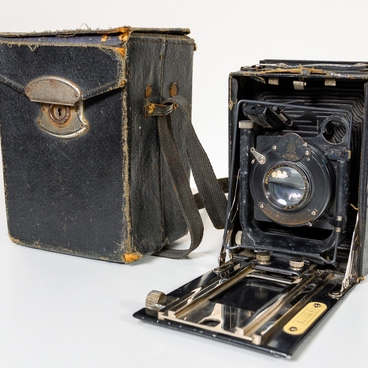Large-format plate photographic cameras “FK” appeared in the USSR in 1930. At that time, they were manufactured by the Commission for the Improvement of the Life of Students at the Leningrad Photo-Cinema Technical School. In 1931, the Leningrad State Optical-Mechanical Plant and the “Geophysics” enterprise in Moscow joined their production.
The “FK” line included three varieties: studio and travel cameras, as well as devices for photographic reproduction. Moreover, they had different image formats, which were identified by the numbers in the name of the model — 13×18, 18×24, or 30×40 centimeters.
The camera from the collection of the National Museum of the Republic of Mari El refers to the “FKD” type — road cameras that were only intended to be used together with a tripod. The model was produced in 1947 at the Leningrad State Optical-Mechanical Plant. Its frame size was 13×18 centimeters. The photographic material was glass plates or sheet photographic film, which were put in wooden double-sided cassettes with a light-tight plastic latch and then pressed with a cover glass.
The camera foldable body is made of wood, and the bellows is made of leatherette. There is a handle on the upper wall for carrying the device. The sides also have screw heads to move the back wall and adjust the focus and locking hooks to fix the body in a folded state. The camera could be stored and transported in a special suitcase.
It included a wooden tripod with sliding supports. The camera was attached to it with a special screw. The inclination of the cassettes could be adjusted, and this allowed taking not only horizontal but also vertical pictures. The model also allowed to photograph buildings without perspective distortion, and the stretchable bellows was suitable for macro photography at a scale of 1:1.
There was no viewfinder for such a camera. To build a frame, a photographer inserted a ground glass instead of a cassette, adjusted the sharpness and focus, and then used the photographic material.
Starting from 1968, FK cameras were released in Kharkiv, at the “Orgtekhnika” factory. In 1987, their production stopped.
The “FK” line included three varieties: studio and travel cameras, as well as devices for photographic reproduction. Moreover, they had different image formats, which were identified by the numbers in the name of the model — 13×18, 18×24, or 30×40 centimeters.
The camera from the collection of the National Museum of the Republic of Mari El refers to the “FKD” type — road cameras that were only intended to be used together with a tripod. The model was produced in 1947 at the Leningrad State Optical-Mechanical Plant. Its frame size was 13×18 centimeters. The photographic material was glass plates or sheet photographic film, which were put in wooden double-sided cassettes with a light-tight plastic latch and then pressed with a cover glass.
The camera foldable body is made of wood, and the bellows is made of leatherette. There is a handle on the upper wall for carrying the device. The sides also have screw heads to move the back wall and adjust the focus and locking hooks to fix the body in a folded state. The camera could be stored and transported in a special suitcase.
It included a wooden tripod with sliding supports. The camera was attached to it with a special screw. The inclination of the cassettes could be adjusted, and this allowed taking not only horizontal but also vertical pictures. The model also allowed to photograph buildings without perspective distortion, and the stretchable bellows was suitable for macro photography at a scale of 1:1.
There was no viewfinder for such a camera. To build a frame, a photographer inserted a ground glass instead of a cassette, adjusted the sharpness and focus, and then used the photographic material.
Starting from 1968, FK cameras were released in Kharkiv, at the “Orgtekhnika” factory. In 1987, their production stopped.



